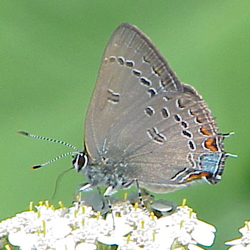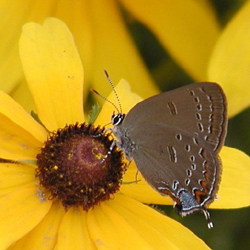Butterfly Atlas
Find a Butterfly
Edward's Hairstreak
Satyrium edwardsii
Named
Grote and Robinson, 1867

Identification
Wingspan: 1 - 1 1/4". Medium brown above and below, with diagnostic median line of separate, white ringed oval spots on underside of both wings. The somewhat similar Banded Hairstreak has median line more or less continuous (not divided into separate ovals), and bordered with white on outer edge only.
Distribution
Southern Manitoba east through southern California to Nova Scotia; southern limit in Midwest is Texas, Arkansas, and western Tennessee; in eastern states, extends south in Appalachians to Georgia (rare south of Pennsylvania). In New England, absent only from northernmost New Hampshire and Vermont and northern half of Maine.
Status in Massachusetts
Locally common in eastern Massachusetts; apparently scarce in western Massachusetts (locally common at Montague Plain only). Occurs in close proximity to larval food plants, especially Scrub Oak (Quercus ilicifolia). In the nineteenth century, known from many localities near Boston and in the Connecticut Valley (abundant in Springfield), Andover, Cape Cod, and Nantucket. Kimball and Jones (1943)noted the species‘ periodic "excessive abundance" on Martha‘s Vineyard, but had no Nantucket records, except those from Scudder, who considered Edward‘s Hairstreak "extremely abundant" on Nantucket. Kimball and Jones theorized that habitat destruction was responsible for the change in the species‘ status in Nantucket from the 1880s to the 1930s. During the Atlas project -and despite an abundance of Scrub Oak on both islands - Edward‘s Hairstreak was recorded at only one locality each on Martha‘s Vineyard and Nantucket. Lack of recent Cape Cod records probably reflects lack of coverage. In preferred habitat, may be abundant at times. Maximum: c. 1000 along 1 1/2 miles of Alden Road, Miles Standish State Forest (Plymouth Co.), 8 July 1988. Most were found nectaring at Blunt-leaved Milkweed (Asclepias amplexicaulis).

Flight Period in Massachusetts
One flight, typically early July to early August (during the Atlas period). Extreme dates: 21 June 1990, Manomet (Plymouth Co.), D. Lang and 10 August 1987, Lynn (Essex Co.), C. Arbogast. Also, "first week of September" (Scudder, 1889).
Larval Food Plants
Oaks, especially Scrub Oak (Quercus ilicifolia). Also, Scarlet Oak (Q. coccinea), Black Oak (Q. velutina), and White Oak (Q.. alba).
Adult Food sources
Numerous midsummer flowers attract Edward‘s Hairstreaks, including Meadowsweet, White Sweet Clover, Wild Indigo, and various milkweeds and dogbanes. Found at 16 wildflower species during the Atlas period.

Habitat
Oak thickets, roadsides through young oak woods, and nearby open areas with nectaring plants.
Life Cycle
OVIPOSITION: Eggs laid singly or rarely in small clusters, under or very near buds of host plant. LARVA: Brownish, with a darker, white striped head and black tubercles with short hairs. CHRYSALIS: Yellow brown and darkly mottled. OVERWINTERING STAGE: Egg.
Edward‘s Hairstreaks may be quite common in the vicinity of their food plant in midsummer. In the spring, the caterpillar emerges from the egg and begins feeding during the day on the oak buds. As the larva grows, it may also feed on young leaves. The more mature larva feeds nocturnally and, according to Scott, spends its days resting at the base of the food plant "within a chimney of litter built by ants. These ants (Formica integra) stay near the larvae and feed on honeydew produced by the fourth stage larvae." Larvae mature in June, pupate, and emerge as adults from late June to late July.
Account Author
Brian Cassie



